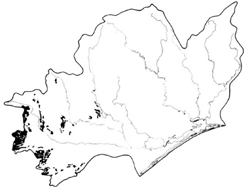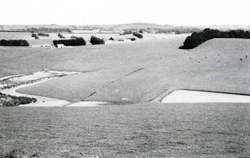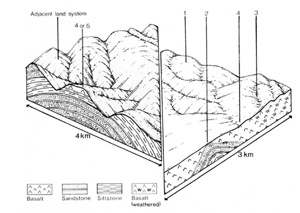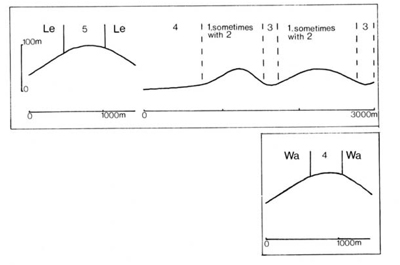Neerim (Nm)
 | Area: 266 sq. km (1.3%) Neerim land system occurs on Tertiary basic volcanics below the subalpine tract, commonly in the west. Low, rounded hills and undulating terrain with intervening clay flats are characteristic. Where aquifers intersect valley floors, for example near Thorpdale, small permanent swamps often occur and are mapped in Morass land system. Most areas have thin weathered regoliths but at higher elevations, such as near Callignee and Aberfeldy, and in some areas at lower elevation, erosion has been more active, exposing fresh basalt. Here soils have formed on fresh rock and are shallow, with those at Callignee and Aberfeldy being similar to soils in parts of Nunniong land system. Thorpdale land system is similar to Neerim land system but is restricted to areas subjected to extensive landslide activity in the past. |  Low hills and undulating terrain with a rounded topography characteristic of Neerim land system. |
| Most soils have developed on remnants of an old deep soil which formed on highly-weathered basalt during a warm, humid climate. These old reddish brown soils are strongly weathered, leached and tend to tie up phosphate in unavailable form. Having a strong, fine structure they are very friable and are sought after for intensive cropping in spite of the phosphate fixation. Where erosion has exposed fresh basalt at higher elevations, somewhat stony, reddish brown, acidic soils have formed. Black, clayey, neutral to alkaline soils have formed on fresh basalt in drier areas at lower elevations near Glenmaggie. These soils lack the strong swelling and shrinking of typical black earths. Scattered throughout the areas on weathered basalt are yellowish brown soils with inclusions of siliceous sediments derived from younger Tertiary sediments or from older rocks exposed by erosion. Most of the native vegetation has been cleared. Open forest II or III, often shrubby or layered at higher elevations, was probably dominant prior to settlement. | ||
| CLIMATE Rainfall, mean (mm) Temperature, mean (°C) Seasonal growth limitations | Annual 800 - 1400; lowest January or February (40 - 70), highest August or October (90 - 120) Annual 8 - 12; lowest July (3 - 7), highest February (16 - 20) Temperature <10°C (av.): May - September Rainfall < potential evapotranspiration: December – February |
| GEOLOGY Age, lithology | Tertiary basalts (Older Volcanics), mainly weathered |
| PHYSIOGRAPHY Landscape Elevation range (m) Relative relief (m) Drainage pattern Drainage density (km/km2) | Low hills and undulating terrain with a rounded topography and intervening clay flats 80 - 1110 40 - 160 Dendritic 1.0 |
| PRESENT LAND USE | Mostly cleared: grazing of dairy and beef cattle and sheep; cropping (limited); apiculture (good honey yield mainly from exotic clovers) |
 |  |
| LAND COMPONENT Percentage of land system Diagnostic features | 1 70 Hillslopes and crests with red soils on highly weathered basalt | 2 10 Slopes and crests with brown soils on mixed basaltic and siliceous parent material (scattered throughout component 1) | 3 10 Valley flats | 4 5 Small plateaux and hill slopes with dark soils on fresh basalt at lower elevations | 5 5 Slopes and small plateaux with red soils on fresh basalt at higher elevations |
| PHYSIOGRAPHY Slope %, typical and (range) Slope shape | 5 - 15, (0 - 30) Concave, some convex | 5 - 10, (0 - 30) Convex | <2, (0 - 5) Straight | 5 - 10, (0 - 20) Convex | Variable, (10 - 40) Convex |
| SOIL | |||||
| Parent material | Basaltic saprolite | Unconsolidated Tertiary sediments or other material with some basaltic influence | Locally derived alluvium | Basalt | |
| Description | Dark brown to dark reddish brown sandy loam to sandy clay loam grading into yellowish red to dark red fine structured clay | Dark greyish brown silt loam to clay loam topsoil grading into yellowish brown mottled clay subsoil | Single observation — dark clay loam over greyish brown mottled clay subsoil | Black to dark greyish brown clay loam to clay changing into dark greyish brown to dark brown, blocky heavy clay | Dark brown to dark reddish brown crumb structured clay loam topsoil grading into reddish brown blocky structured clay loam or light clay subsoil; often basalt floaters or stones |
| Classification | Krasnozems; rarely Euchrozems Gn3.11, Gn4.11, rarely Gn4.71 | Xanthozems; probably Yellow Podzolic Soils Gn3.51, Gn3.71, Gn4.34 | Humic Gleys Gn3.41 | Prairie Soils, Black Earths Dd3.11, Dd3.12, Ug5.11 | Chocolate Soils, Krasnozems Um6.13, Gn3.11, Gn4.11, Gn4.41 |
| Surface texture | Sandy loam to sandy clay loam | Silt loam to clay loam | Clay loam | Clay loam to clay | Clay loam |
| Surface consistence | Friable when moist | Friable when moist | Friable when moist | Firm when moist | Friable when moist |
| Depth (m) | 0.9-1.5 | >1.5 | >2.0 | 0.6-1.5 | 0.2-1.8 |
| Nutrient status | Low | Low | Moderate | Moderate to high | Moderate |
| Available soil water capacity | Low | Low to moderate | Moderate | Moderate | Moderate to high |
| Perviousness to water | Very rapid | Moderately rapid | Slow | Slow | Rapid |
| Drainage | Good | Moderately good | Very poor to poor | Moderately good | Good |
| Exposed stone (%) | 0 | 0 | 0 | 0- 5 | 0- 15 |
| Sampled profile number | 31 | - | - | - | 37 |
| NATIVE VEGETATION Structure of vegetation and characteristic species of dominant stratum (+ Predominant species) | Structure and species difficult to determine due to clearing— species given are those recorded | ||||
E. cypellocarpa, E. globoidea, E. macrorhyncha, E. obliqua, E. radiata, E. rubida | E. cypellocarpa, E. obliqua | E. ovata | E. melliodora, E. globulus, E. tereticornis | E. obliqua, E. ovata, E. rubida, E. viminalis | |
Disturbance | Affected process and trend | Primary resultant deterioration | Casual activities | Primary off-site process | ||
Form | Susceptibility of components | Incidence with components | ||||
— reduction in leaf area, rooting depth and/or perenniality
|
resulting in: a) increased deep percolation and leaching b) increased regolith wetness Decreased root-binding |
Nutrient loss Landslip Landslip |
1,2,5 ; moderate 3,4 ; low 1,2; low – moderate 1,2; low - moderate |
Not determined Uncommon Uncommon |
Removal of trees Accelerated by major disturbance of the native vegetation Accelerated by major disturbance of the native vegetation |
Increased movement of water to groundwater; increased base-flow of streams Increased sediment load Increased sediment load |
|
|
|
4 ; low |
|
|
|
|
With Reduced infiltration |
Sheet and rill erosion |
2,3,5; moderate 4; high 1,2,5; moderate 4; low |
Common |
As for sheet and rill erosion above |
Increased flash flows |
|
|
|
|
|
|
|
| ||||||


